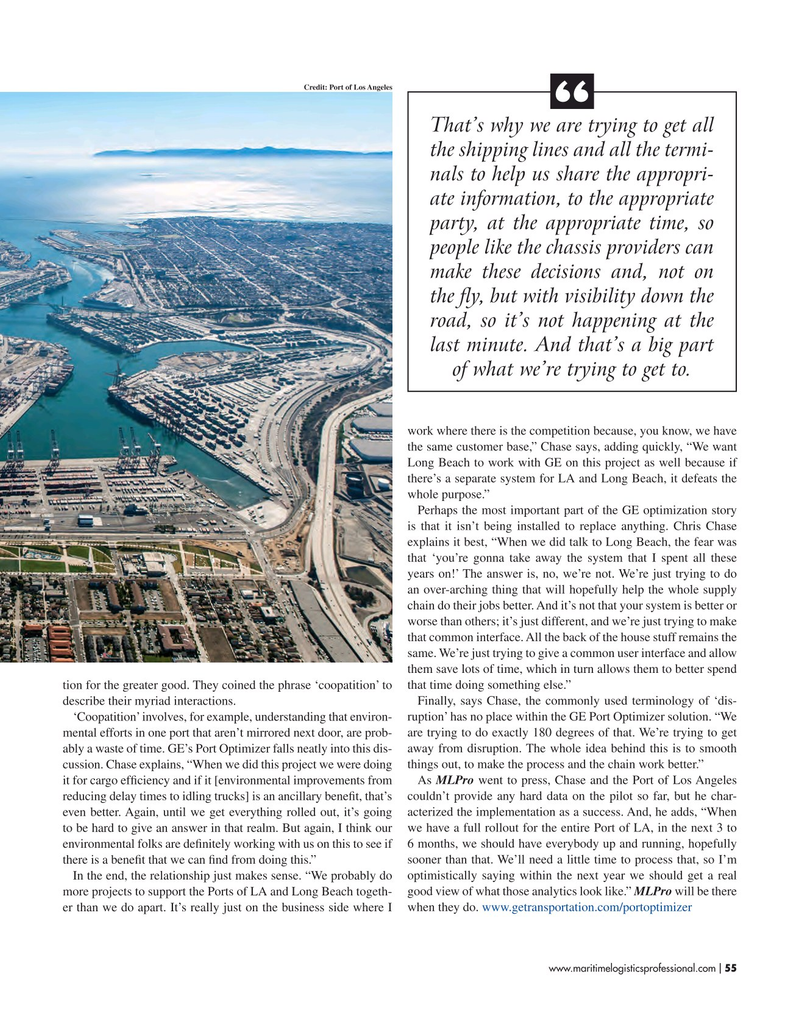
Page 55: of Maritime Logistics Professional Magazine (Sep/Oct 2018)
Liner Shipping & Logistics
Read this page in Pdf, Flash or Html5 edition of Sep/Oct 2018 Maritime Logistics Professional Magazine
Credit: Port of Los Angeles
That’s why we are trying to get all the shipping lines and all the termi- nals to help us share the appropri- ate information, to the appropriate party, at the appropriate time, so people like the chassis providers can make these decisions and, not on the fy, but with visibility down the road, so it’s not happening at the last minute. And that’s a big part of what we’re trying to get to.
work where there is the competition because, you know, we have the same customer base,” Chase says, adding quickly, “We want
Long Beach to work with GE on this project as well because if there’s a separate system for LA and Long Beach, it defeats the whole purpose.”
Perhaps the most important part of the GE optimization story is that it isn’t being installed to replace anything. Chris Chase explains it best, “When we did talk to Long Beach, the fear was that ‘you’re gonna take away the system that I spent all these years on!’ The answer is, no, we’re not. We’re just trying to do an over-arching thing that will hopefully help the whole supply chain do their jobs better. And it’s not that your system is better or worse than others; it’s just different, and we’re just trying to make that common interface. All the back of the house stuff remains the same. We’re just trying to give a common user interface and allow them save lots of time, which in turn allows them to better spend tion for the greater good. They coined the phrase ‘coopatition’ to that time doing something else.” describe their myriad interactions. Finally, says Chase, the commonly used terminology of ‘dis- ‘Coopatition’ involves, for example, understanding that environ- ruption’ has no place within the GE Port Optimizer solution. “We mental efforts in one port that aren’t mirrored next door, are prob- are trying to do exactly 180 degrees of that. We’re trying to get ably a waste of time. GE’s Port Optimizer falls neatly into this dis- away from disruption. The whole idea behind this is to smooth cussion. Chase explains, “When we did this project we were doing things out, to make the process and the chain work better.” it for cargo effciency and if it [environmental improvements from As MLPro went to press, Chase and the Port of Los Angeles reducing delay times to idling trucks] is an ancillary beneft, that’s couldn’t provide any hard data on the pilot so far, but he char- even better. Again, until we get everything rolled out, it’s going acterized the implementation as a success. And, he adds, “When to be hard to give an answer in that realm. But again, I think our we have a full rollout for the entire Port of LA, in the next 3 to environmental folks are defnitely working with us on this to see if 6 months, we should have everybody up and running, hopefully there is a beneft that we can fnd from doing this.” sooner than that. We’ll need a little time to process that, so I’m
In the end, the relationship just makes sense. “We probably do optimistically saying within the next year we should get a real more projects to support the Ports of LA and Long Beach togeth- good view of what those analytics look like.” MLPro will be there er than we do apart. It’s really just on the business side where I when they do. www.getransportation.com/portoptimizer www.maritimelogisticsprofessional.com 55
I

 54
54

 56
56
